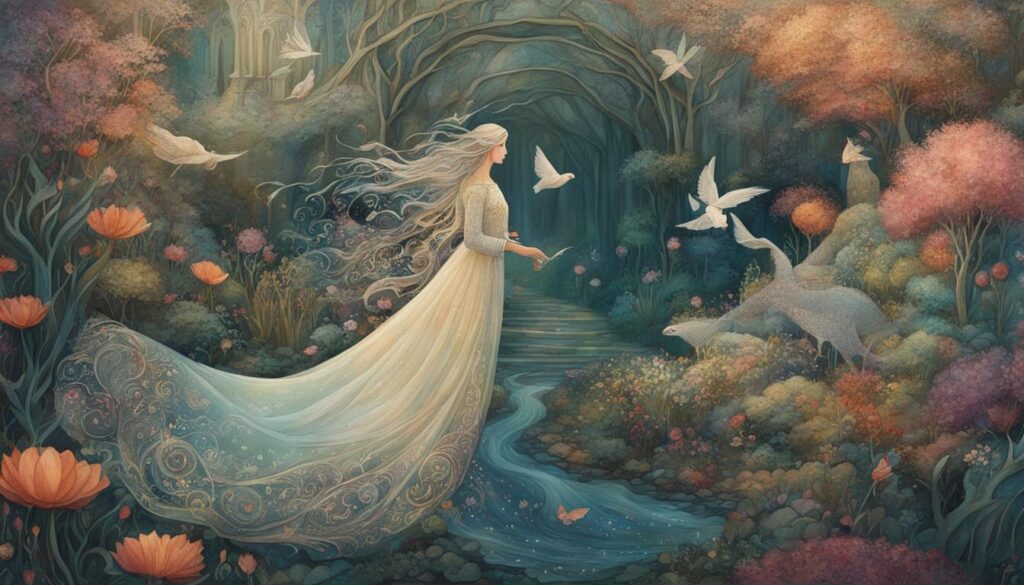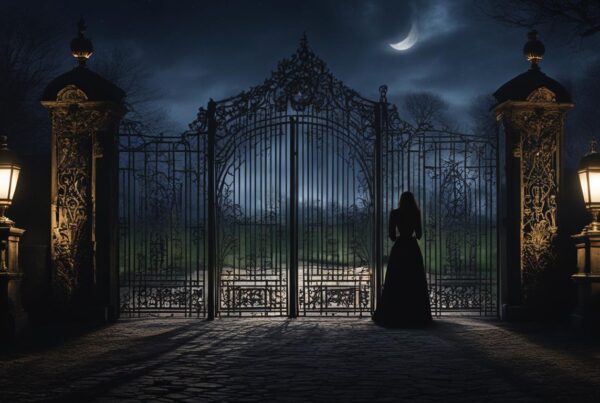Immerse yourself in the enchanting world of Ellen Kushner’s award-winning work with our in-depth fantasy audiobook review of “Thomas the Rhymer”. Blurring the lines between the familiar and the fantastical, Kushner takes us through the weaves of magical realism with a rendition that captivates and transports listeners to an ethereal territory of lyrical beauty. This audiobook analysis ventures into the realm of legends, echoing the heartstrings of traditional folklore through a contemporary lens.
With the allure of mythic tunes and the tangible touch of realism, “Thomas the Rhymer” promises an audio journey that intertwines the complexities of human emotions with the simplicity of age-old tales. Prepare to explore how Kushner harnesses the power of narrative to reignite the flame of an ancient Scottish ballad in our comprehensive review.
Exploring the Legend Behind “Thomas the Rhymer”
The tale of Thomas the Rhymer, steeped in Scottish legends and historical folklore, has captivated the imagination of scholars and enthusiasts alike. This legendary figure, also known as Thomas of Erceldoune, was said to possess the gift of prophecy, a mystique that has only grown with the centuries. His story is a fascinating blend of historical account and mythical narrative, epitomized in the ballad of Thomas the Rhymer. At the heart of this ballad are themes of enchantment, foresight, and the age-old exchange between mortality and the otherworldly.
Drawing upon scholarly articles, we find an individual who was not only a reputed seer but also a person who lived in the 13th century, with his life documented in various historical texts. Literary works focusing on ballads and oral traditions further illuminate the character of Thomas the Rhymer, revealing how history and myth intertwine to create a timeless legend. Knowledge from folklore experts and cultural historians sheds light on the societal and cultural impacts of these tales within the fabric of Scottish heritage. Below we delve into the sources that help us piece together the enigma of Thomas the Rhymer’s legend.
| Source of Insight | Contributions to the Thomas the Rhymer Legend |
|---|---|
| Scholarly Articles | Provide an historical perspective and validate existence through records |
| Literature on Ballads | Ballads as a medium for preserving and transmitting the legend orally |
| Expert Insights | Interpretations and analysis of Thomas the Rhymer’s influence on culture and folklore |
The enduring nature of such legends mirrors the undying fascination and reverence for stories that transcend time. Through the historical echo of Thomas’s purported prophecies, the enchanted melodies of ballads, and the scholarly passion for ancient tales, the Rhymer’s voice still whispers to those who seek the wisdom of ages past.
“Thomas the Rhymer” Audiobook Review
The enchantment of “Thomas the Rhymer” extends beyond the printed page with its audiobook adaptation. Ellen Kushner, not only the author but also the narrator, delivers a performance that lands a masterful touch to the auditory experience. Here, we delve into what makes this audiobook an exceptional encounter for listeners and how it stands up next to the traditional written version. Furthermore, we explore the audio incarnation of Scottish ballads that are at the heart of this magical tale.
Narration and Audio Performance
In this audiobook performance review, Ellen Kushner’s multifaceted role as an author-cum-narrator is brought to the fore. Listeners have attested that Kushner’s narration is both passionate and authentic, capturing the nuances of each character with precision. Her voice, carrying the cadence of a seasoned storyteller, envelops listeners in the lush world she has created. Critics and fans alike laud her delivery as it enhances the narrative, embodying the lyrical and mystical elements of the story.
Comparison to the Text Version
When positioned alongside the print version, the audiobook adaptation of “Thomas the Rhymer” offers a distinct experience. Through Kushner’s vocal talents, the prose breathes life into the characters and setting in a way that text alone may not fully capture. Each medium has its fervent advocates; however, the audiobook brings an additional layer of sensory engagement, particularly for those who revel in the spoken word.
Audio Experience of the Scottish Ballads
The audiobook’s treatment of Scottish ballads is noteworthy. These melodies, pivotal to the story’s foundation, gain an ethereal quality as they are woven throughout the narration. Fans commend the audiobook for preserving the ballads’ soulful essence and providing an immersive soundscape that transports listeners directly into the heart of the tale. The melodic interludes interlace seamlessly with Kushner’s narration, making the adaptation a tribute to the original ballads and their role in Scottish folklore.
The Magic of Ellen Kushner’s Storytelling
Fantasy storytelling is a craft that transcends mere plot—it’s the intricate weaving of a magical narrative that captivates the reader. Ellen Kushner stands as a master in this art, with a writing style that infuses each tale with a sense of wonder. Her unique ability to intertwine folklore and myth with contemporary relevance has set a benchmark in the realm of fantasy literature.

Ellen Kushner’s Narrative Style
The signature of Ellen Kushner’s writing lies in her sophisticated dialogue and lyrical prose, creating a tapestry of words that feels both enchanting and intentional. Critics have noticed how her storytelling not only entertains but also conveys deeper meanings, engaging readers in a narrative dance of shadow and light.
“Kushner doesn’t just tell a story, she ensnares you in a rich tapestry where characters live and breathe with an almost poetic grace.” – Fantasy Book Review
Folklore and Mythical Elements
Integrating folklore and myth into modern fantasy storytelling demands a delicate balance—a challenge Kushner appears to meet with ease. Her seamless blending of these elements into her narratives invites readers to explore a fantastical world that mirrors the complexities of our own. The table below illustrates how Kushner’s writing style enchants and immerses readers by using magical narrative techniques drawn from folklore traditions.
| Technique | Description | Example from Kushner’s Work |
|---|---|---|
| Character Archetypes | Using timeless figures from folklore to create relatable characters. | The wise mentor figure akin to a wizard or guide. |
| Mythic Structure | Mirroring the classic ‘hero’s journey’ to structure the story. | A protagonist’s transformation from naivete to wisdom. |
| Symbolic Language | Embedding symbolic meaning in language to add depth to the narrative. | Use of seasons to symbolize phases of life. |
Through her exploration of these tried-and-true storytelling components, Kushner revitalizes the genre, making it clear why her place in the pantheon of fantasy storytelling is well-deserved. Her magical narrative techniques coupled with her authentic voice resonate with fans across the globe, securing Ellen Kushner’s writing style as a hallmark of fantasy excellence.
Character Development in “Thomas the Rhymer”
The intricate journey of characters in Ellen Kushner’s “Thomas the Rhymer” unfolds a tapestry rich with character analysis, fantasy character growth, and the ethereal allure of mythological figures. It weaves a compelling narrative that takes fantasy literature beyond mere escapism, inviting readers to explore deeper realms of transformation and enchantment.
Thomas: From a Bard to an Enchanted Minstrel
Thomas, the protagonist, transitions from a mere earthly bard to a being touched by the supernatural world. This metamorphosis reflects the classic fantasy character growth arc whereby a character’s experiences in a mythical environment lead to profound personal development. Scholars have compared Thomas’s journey to those found in historical lore, discussing the ways in which Thomas’s character aligns with the legendary Thomas the Rhymer and deviates to fulfill the novel’s thematic objectives.
The Queen of Elfland: A Mysterious Muse
The Queen of Elfland stands as a pivotal mythological figure in the story, often analyzed for her mysterious nature and influence over Thomas’s growth. Literary critiques highlight how the Queen—both muse and antagonist—propels the plot and deepens the novel’s exploration of mystical love and otherworldly wisdom. Her enigmatic presence echoes through the pages, continuously impacting Thomas’s life and music.
Characters in Kushner’s realm are not mere pawns but catalysts of change, challenging readers to draw parallels between the enchantment of fairy tales and the transformative power of human experiences.
Themes and Symbols in “Thomas the Rhymer”
Ellen Kushner’s “Thomas the Rhymer” captivates readers with its intricate exploration of literary themes, particularly those surrounding love and sacrifice in literature. Through her vivid portrayal of the mythic, Kushner invites us to delve deeper into the world of symbolism in fantasy, using her narrative to bridge the ethereal and the tangible realms.
Exploring the Theme of Love and Sacrifice
The tale of Thomas and the Queen of Elfland is steeped in the age-old narrative of love and sacrifice. It’s a theme that harks back to the very roots of storytelling. In this fantastical journey, Kushner dissects the complexities of love—its power to transcend the boundaries of the mortal realm, and the sacrifices that often accompany it. The protagonist’s choices serve as poignant reflections on the human condition, resonating with readers who have grappled with the sacrifices made in the name of love.
The Interplay of the Mortal and Faerie Realms
The intermingling of the mortal and faerie realms within “Thomas the Rhymer” offers a rich tapestry of symbolism. Kushner uses this device to shine a light on the often overlooked parallels between our world and the fabled lands of fantasy. Conflict and harmony between these realms provoke thoughts about our own societal divides, and the barriers we erect between reality and the fantastical. Characters navigate these boundaries, embodying deeper meanings and playing a part in the portrayal of a diverse array of literary themes.
- Depiction of the ephemeral nature of time in the Faerie realm
- Symbolic consequences of crossing between worlds
- Contrasts between ephemeral beauty and the stark realities of life
By immersing readers in her world of myth and magic, Kushner allows us to explore these literary themes, using symbolism in fantasy to reflect on our own lives and world. The underlying narrative of “Thomas the Rhymer” becomes an allegorical journey, where love and sacrifice emerge not just as literary themes but as universal truths.
Setting the Scene: The Historical and Cultural Backdrop
Understanding the historical setting and cultural context in fantasy is crucial to grasp the depth of works like those that evoke medieval Scotland in literature. These elements work synergetically to establish a sense of authenticity and ground fantasy in a semblance of reality.
The portrayal of medieval Scotland is not merely about donning tartans and wielding claymores; it involves a meticulous reconstruction of the era’s ethos. The cultural tapestry of this time was rich with the intensity of Norse sagas, the stirring legends of the Highland clans, and the daily struggles and triumphs that defined the average Scot. Integrating such elements into fantasy can elevate the narrative from the fantastical to something that resonates with historical gravitas.
Historical accuracy
in portraying these times often dictates the success with which readers can immerse themselves in a story’s world. This intricate balance between the real and the imagined is often what fans of fantasy seek as they traverse the literary landscapes crafted by contemporary storytellers.

Literary explorations and documents establishing the cultural context in fantasy show a wide array of traditions and social norms that authors can draw from to enrich their settings. From the clan-based social structure to the vibrant oral tradition of storytelling and song, medieval Scotland offers a wellspring of inspiration.
Central to understanding these tales is the recognition that the mythic and mundane were often intertwined in the minds of the populace, creating a worldview in which the mystical could exist alongside the quotidian.
Scholarly discussions and studies further emphasize how the rugged landscapes, the castles and abbeys, and the ever-changing political landscape influence character decisions and plot directions, embodying the essence of the terrain and history they’re set upon.
Below we find a comparison of key aspects of medieval Scottish life and how they could be seamlessly woven into the realm of fantasy literature:
| Medieval Scottish Element | Utility in Fantasy Context |
|---|---|
| Clan Systems and Allegiances | Frameworks for character loyalties and conflicts |
| Historical Battles and Sieges | Blueprints for epic battle scenes and political intrigue |
| Folk Beliefs and Superstitions | Underlining themes of fate, destiny, and the supernatural |
| Troubadours and Bards | Devices for storytelling and maintaining oral traditions within the narrative |
| Medieval Architecture | Visual grounding for the reader and potential plot devices |
In essence, the careful layering of medieval Scotland’s stark realities with elements of the fantastic allows for a cultural context in fantasy that not only entertains but educates, offering readers a portal to a time where history and legend coalesce.
The Impact of Music and Song in the Story
Within the rich tapestry of fantasy literature, music often serves as a conduit for storytelling, carrying with it the cultural heartbeat of a narrative. Ellen Kushner’s “Thomas the Rhymer” is a testament to this tradition, seamlessly interweaving traditional Scottish ballads into the fabric of the narrative. These historical ballads not only provide a melodious backdrop but deepen the readers’ immersion into the mystical realm of the story.
Role of Traditional Music in the Narrative
Music in fantasy, particularly that of traditional Scottish ballads, plays a pivotal role in “Thomas the Rhymer”, symbolizing much more than mere entertainment. The ballads serve as narrative vehicles, delivering themes, character insights, and foretelling events through their lyrical content. Kushner’s affinity for using music as a narrative tool exemplifies a deep understanding of the ballads’ power within the genre and their efficacy in character development.
Interpreting the Riddles in the Ballads
The veiled meanings and riddles in literature found within the Scottish ballads challenge both the characters and readers to uncover hidden layers of the story. Kushner skillfully employs these riddles to drive the plot and define her characters’ destinies. Decoding these riddles becomes a journey in itself, adding an interactive element to the reading experience and an additional layer of complexity to the narrative structure.
| Ballad | Role in the Story | Thematic Symbolism |
|---|---|---|
| “Thomas the Rhymer” | Introduction to Thomas’s mystical encounter | Fate and prophecy |
| “The Elfin Knight” | Represents the challenges of the faerie world | Overcoming the impossible |
| “The Twa Magicians” | Character transformation and adaptability | The power of wit and cunning |
| “Tam Lin” | Mortal and faerie realm interaction | Love’s triumph over enchantment |
Comparing “Thomas the Rhymer” to Classic Fantasy Works
In the realm of fantasy literature, it’s always fascinating to unearth the connections between contemporary tales and the classic works that have shaped the genre. Ellen Kushner’s “Thomas the Rhymer” stands as a significant contribution to high fantasy literature, inviting a deeper fantasy genre comparison to understand its place within the tradition. The unique fantasy narrative crafted by Kushner resonates with the timeless qualities found in high fantasy epics, yet it diverges to establish a distinctive voice in a crowded field.
Similarities to High Fantasy Epics
The influence of high fantasy literature on “Thomas the Rhymer” cannot be overlooked. Its robust world-building, the palpable interweaving of the mortal and the mystical, and a hero’s journey akin to epics of old, are elements that fans of the genre will find familiar. Yet, when conducting a fantasy genre comparison, one notices how these tropes are infused with a lyrical quality that is deeply rooted in Scottish folklore, much like the ballads from which the story draws inspiration.
Distinguishing Features of Kushner’s Work
Kushner’s narrative is renowned for its lyrical prose and the seamless integration of music, which sets it apart as a unique fantasy narrative. Her innovative approach to the genre involves a blend of historical authenticity and artistic narrative freedom that offers a refreshing departure from more conventional high fantasy literature. This intertwining of historical depth with mythical elements fosters a compelling narrative where every character and their journey feels both grandiose and intimately human.
| Feature | Classic High Fantasy | “Thomas the Rhymer” |
|---|---|---|
| World-Building | Elaborate fantastical realms | Blend of real historical settings with mythical elements |
| Protagonist | Often a figure fated for greatness | A bard on a transformative journey |
| Narrative Style | Typically epic and expository | Lyrical and rooted in musical traditions |
| Mysticism | Highly fantastical magic systems | Subtle enchantment woven into reality |
| Themes | Largely centered around good versus evil | Explores personal sacrifice and the nuances of love |
Reception and Critiques of “Thomas the Rhymer”
The enchanting narrative of “Thomas the Rhymer” has captivated the hearts of many within the fantasy genre, gathering both high acclaim and critique from its audience and literary scholars. Authored by Ellen Kushner, the novel has traversed the journey from mere storytelling to becoming an artefact of fantasy literature recognized for its depth, ingenuity, and the seamless weaving of mythical elements within the rich tapestry of its narrative.
Award-Winning Aspects of the Book
Amongst its many accolades, “Thomas the Rhymer” has secured a prestigious position in the annals of fantasy book awards. Garnering not only a World Fantasy Award but also the Mythopoeic Award, the novel’s excellence has been stamped by the highest seals of literary merit. These accolades are a testament to Kushner’s masterful blend of folklore with lyrical prose, creating a mesmerizing experience that resonates with lovers of the magical realism genre.
Critical Reception by Fantasy Literature Experts
Expert reviews of “Thomas the Rhymer” underscore its reception in academic and critical circles, with many lauding its authenticity and fidelity to traditional Scottish legends. Literature experts have recognized Kushner’s work for its intellectual rigor and artful narrative structure, weaving criticism and praise alike into analyses that celebrate the novel’s profound impact on the fantasy literary landscape. Audience reception further echoes this sentiment, marking the book as a beloved staple with strong sales figures and positive reader feedback, cementing its status within the realm of timeless fantasy literature.



